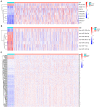Exploring the Effect of Differentially Expressed Long Non-coding RNAs Driven by Copy Number Variation on Competing Endogenous RNA Network by Mining Lung Adenocarcinoma Data
- PMID: 33585468
- PMCID: PMC7876300
- DOI: 10.3389/fcell.2020.627436
Exploring the Effect of Differentially Expressed Long Non-coding RNAs Driven by Copy Number Variation on Competing Endogenous RNA Network by Mining Lung Adenocarcinoma Data
Abstract
Lung cancer is the first cause of cancer death, and gene copy number variation (CNV) is a vital cause of lung cancer progression. Prognosis prediction of patients followed by medication guidance by detecting CNV of lung cancer is emerging as a promising precise treatment in the future. In this paper, the differences in CNV and gene expression between cancer tissue and normal tissue of lung adenocarcinoma (LUAD) from The Cancer Genome Atlas Lung Adenocarcinoma data set were firstly analyzed, and greater differences were observed. Furthermore, CNV-driven differentially expressed long non-coding RNAs (lncRNAs) were screened out, and then, a competing endogenous RNA (ceRNA) regulatory network related to the gene CNV was established, which involved 9 lncRNAs, seven microRNAs, and 178 downstream messenger RNAs (mRNAs). Pathway enrichment analyses sequentially performed revealed that the downstream mRNAs were mainly enriched in biological pathways related to cell division, DNA repair, and so on, indicating that these mRNAs mainly affected the replication and growth of tumor cells. Besides, the relationship between lncRNAs and drug effects was explored based on previous studies, and it was found that LINC00511 and LINC00942 in the CNV-associated ceRNA network could be used to determine tumor response to drug treatment. As examined, the drugs affected by these two lncRNAs mainly targeted metabolism, target of rapamycin signaling pathway, phosphatidylinositol-3-kinase signaling pathway, epidermal growth factor receptor signaling pathway, and cell cycle. In summary, the present research was devoted to analyzing CNV, lncRNA, mRNA, and microRNA of lung cancer, and nine lncRNAs that could affect the CNV-associated ceRNA network we constructed were identified, two of which are promising in determining tumor response to drug treatment.
Keywords: LUAD; TCGA; ceRNA network; copy number variation; lncRNA.
Copyright © 2021 Hu, Xu, Lu, Zhang, Xu, Xu, Jiang, Zeng, Chen and He.
Conflict of interest statement
The authors declare that the research was conducted in the absence of any commercial or financial relationships that could be construed as a potential conflict of interest.
Figures








Similar articles
-
Dysregulated ceRNA network modulated by copy number variation-driven lncRNAs in breast cancer: A comprehensive analysis.J Gene Med. 2023 Mar;25(3):e3471. doi: 10.1002/jgm.3471. Epub 2023 Jan 10. J Gene Med. 2023. PMID: 36525372
-
Identification of a ceRNA Network Driven by Copy Number Variations in Esophageal Cancer.J Nippon Med Sch. 2023;90(6):426-438. doi: 10.1272/jnms.JNMS.2023_90-611. J Nippon Med Sch. 2023. PMID: 38246614
-
Comprehensive analysis of prognostic biomarkers in lung adenocarcinoma based on aberrant lncRNA-miRNA-mRNA networks and Cox regression models.Biosci Rep. 2020 Jan 31;40(1):BSR20191554. doi: 10.1042/BSR20191554. Biosci Rep. 2020. PMID: 31950990 Free PMC article.
-
Reconstruction and Analysis of the Differentially Expressed IncRNA-miRNA-mRNA Network Based on Competitive Endogenous RNA in Hepatocellular Carcinoma.Crit Rev Eukaryot Gene Expr. 2019;29(6):539-549. doi: 10.1615/CritRevEukaryotGeneExpr.2019028740. Crit Rev Eukaryot Gene Expr. 2019. PMID: 32422009 Review.
-
Long non-coding RNAs in non-small cell lung cancer: functions and distinctions from other malignancies.Transl Cancer Res. 2019 Nov;8(7):2636-2653. doi: 10.21037/tcr.2019.10.22. Transl Cancer Res. 2019. PMID: 35117021 Free PMC article. Review.
Cited by
-
The development of a novel signature based on the m6A RNA methylation regulator-related ceRNA network to predict prognosis and therapy response in sarcomas.Front Genet. 2022 Oct 12;13:894080. doi: 10.3389/fgene.2022.894080. eCollection 2022. Front Genet. 2022. PMID: 36313417 Free PMC article.
-
Multi-omics approach for identifying CNV-associated lncRNA signatures with prognostic value in prostate cancer.Noncoding RNA Res. 2023 Oct 10;9(1):66-75. doi: 10.1016/j.ncrna.2023.10.001. eCollection 2024 Mar. Noncoding RNA Res. 2023. PMID: 38075203 Free PMC article.
-
Risk Scores Based on Six Survival-Related RNAs in a Competing Endogenous Network Composed of Differentially Expressed RNAs Between Clear Cell Renal Cell Carcinoma Patients Carrying Wild-Type or Mutant Von Hippel-Lindau Serve Well to Predict Malignancy and Prognosis.Front Oncol. 2021 Oct 25;11:726671. doi: 10.3389/fonc.2021.726671. eCollection 2021. Front Oncol. 2021. PMID: 34760693 Free PMC article.
-
Immune-Related lncRNA Pairs as Prognostic Signature and Immune-Landscape Predictor in Lung Adenocarcinoma.Front Oncol. 2022 Jan 10;11:673567. doi: 10.3389/fonc.2021.673567. eCollection 2021. Front Oncol. 2022. PMID: 35083132 Free PMC article.
-
LncRNA LINC00520 aggravates cell proliferation and migration in lung adenocarcinoma via a positive feedback loop.BMC Pulm Med. 2021 Sep 8;21(1):287. doi: 10.1186/s12890-021-01657-6. BMC Pulm Med. 2021. Retraction in: BMC Pulm Med. 2024 Jul 16;24(1):344. doi: 10.1186/s12890-024-03158-8. PMID: 34496829 Free PMC article. Retracted.
References
LinkOut - more resources
Full Text Sources
Other Literature Sources
Research Materials

